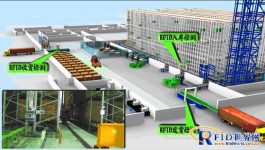
A case of the Internet of Things system in a provincial power metering center
[ad_1]
construction background
With the rapid development of our economy and the increasing demand for daily electricity, the pressure on power construction is also increasing and the requirements are getting higher and higher. For power asset management, there are problems such as low efficiency of manual decentralized verification, high inventory and low capacity of manual storage, and opaque inventory assets. How to quickly, conveniently and accurately store, detect and transport power components is currently a great test for power grid construction. Sihai Cloud Networking Co., Ltd. is based on its own independent technologies such as the Internet of Things, combined with the most advanced technologies in the fields of sensing, cloud computing, cloud storage, etc., as well as mature GIS systems, through the production, warehousing, management, and management of power assets. Comprehensive management and tracking of distribution, verification, installation, use, scrap, etc., improve production flow capacity, track the flow direction and use of components in real time, and realize the linkage of verification, warehousing, and distribution systems across the province, and remote copying, management, and feedback. Power device management is easier and more convenient, saving a lot of manpower and material costs, making power system management more efficient, and construction more advanced and reliable.
aim of design
Through the application of Internet of Things RFID and other sensing technologies, computer networks, databases and other technologies to achieve:
Intelligent production management: By optimizing the production management process, all-round, intelligent and specific management can be achieved, so as to achieve the purpose of improving efficiency, saving costs, reducing labor workload, and automatically statistical data;
Meter verification automation: realize meter verification through centralized verification management mode and automatic verification assembly line production method, improve verification efficiency and reduce labor costs;
Intelligent warehousing of meters: The provincial, municipal, and county-level meter warehouses all use intelligent warehousing systems of different scales to improve the inbound and outbound capacity, reduce inventory costs, and realize fully automated and fully transparent management of meter warehouses.
Logistics of metered distribution: Through the centralized distribution business model, a three-level linkage distribution system at the provincial, municipal and county levels is realized to reduce logistics costs.
Integration of full life cycle management: realize the full life cycle management of assets from production, procurement, verification, warehousing, distribution, installation, use, and scrappingRFIDAutomatic identification and control, improve the real-time performance of data, and reduce the management cost of data collection and statistics;
Remote real-time controllability of all processes: to achieve full integration and remote real-time control of meter demand, procurement, arrival, verification, warehousing, distribution, delivery and other processes. The management is remotely visible and controllable.
Through the realization of the above functions, seven automations can be achieved: verification automation, warehousing automation, distribution automation, identification automation, data transmission automation, statistical automation, and analysis automation.
System Components
1. Automatic verification system
2. Intelligent warehousing system
3. Production management system
4. Distribution scheduling system
5. Use management
1. Production management system
All-round management from budget, demand, procurement, arrival, on-site scheduling to manufacturing, packaging, and delivery
Features:
• Centralized procurement, bulk delivery
• Automatic batch identification of arrival box list
• Automatically pick up the goods, and unload the goods directly to the production line
System functions:

1. Intelligent measurement verification;
2. Production process management;
2. Intelligent warehousing system
Automatic batch identification of inbound and outbound management:
Automatic warehousing system:
Automatic storage system:
Automatic sorting verification system:
4. Three-level linkage of provinces, cities and counties
Applications:
A case of the Internet of Things system in a provincial power metering center
[ad_2]



